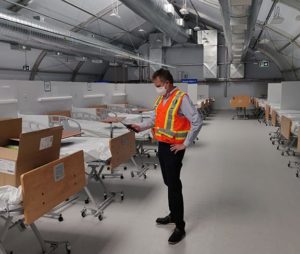Hospital Outdoor COVID-19 Pandemic Response Unit

In response to the COVID-19 pandemic health crisis, a local Ontario hospital began this spring to construct a temporary Pandemic Response Unit on its grounds. The modular tent-like structure was built in preparation for a potential influx of COVID-19 patients over the course of the outbreak in the region. This new external Pandemic Response Unit can hold up to 80-plus patients and is situated on the hospital’s south parking lot. If needed, two additional Pandemic Response Units are ready to be erected on-site in response to any potential surging patient volumes. All combined, the units can provide capacity for as many as 270 additional pandemic care spaces.
Occupational and Patient Care Noise Assessment
HGC Engineering was contacted and asked to assess the potential level of noise disruption on patient and healthcare worker wellbeing, conversational privacy and intelligibility in the structure from:
- Delivery vehicles driving past the tent
- Vehicles driving and parking within the surface lot area where the Pandemic Response Unit is located
- Reoccurring ambient sound emanating from the operating HVAC units built into the unit’s structure
Healthcare HVAC Noise Level Criteria
 The American Society of Heating, Refrigeration, and Air-Conditioning Engineers (ASHRAE) provide recommended sound levels from heating ventilating and air-conditions (HVAC) sources in buildings in terms of Noise Criterion (NC) curves. In a hospital setting, operating and procedure rooms, and patient wards should ideally be designed within the range of about NC-35. There are however no guidelines provided for facilities such as this, where patient beds are located directly adjacent to each other, with no walls demising patient beds. In such a case, a higher sound level may be desirable to provide a somewhat increased level of speech privacy. Experience suggests that for typical private conversations, effectiveness of communication will be reduced at background sound levels of about NC-50 to NC-55, although this value will vary based on the vocal effort of the speaker, among other factors.
The American Society of Heating, Refrigeration, and Air-Conditioning Engineers (ASHRAE) provide recommended sound levels from heating ventilating and air-conditions (HVAC) sources in buildings in terms of Noise Criterion (NC) curves. In a hospital setting, operating and procedure rooms, and patient wards should ideally be designed within the range of about NC-35. There are however no guidelines provided for facilities such as this, where patient beds are located directly adjacent to each other, with no walls demising patient beds. In such a case, a higher sound level may be desirable to provide a somewhat increased level of speech privacy. Experience suggests that for typical private conversations, effectiveness of communication will be reduced at background sound levels of about NC-50 to NC-55, although this value will vary based on the vocal effort of the speaker, among other factors.
Audible sound intrusions from exterior sources (road traffic, aircraft, etc.) are routinely accepted within occupied buildings. In general, intrusive noises that are more than about 10 A-weighted deciBels (dBA) above the ambient sound level would become clearly noticeable and could thus potentially disturb a patient.
Potential Noise Scenario Simulations
 At the time that team members of HGC Engineering visited the site to conduct sound level measurements, the modular tent structure was furnished with partitions and beds, but was otherwise not yet occupied. As a result, our acousticians created scenarios on-site that simulated and approximated the noise environment that might exist during operational conditions.
At the time that team members of HGC Engineering visited the site to conduct sound level measurements, the modular tent structure was furnished with partitions and beds, but was otherwise not yet occupied. As a result, our acousticians created scenarios on-site that simulated and approximated the noise environment that might exist during operational conditions.
Sound level measurements were taken on both sides of the tent structure, inside and out, under the following scenarios: while a car was left idling, while a car door was closing, and while a car horn was beeping. To assess the level of intrusion from various vehicle passes on the drive aisle, measurements were conducted as a truck, tractor-trailer, passenger vehicle and small van drove past the structure and over speed bumps.
To assess the sound levels from the HVAC units (which were operating), measurements were conducted along the south aisle of the structure, at several supply air grilles. Some additional measurements were conducted above-selected beds, and along the north aisle to confirm the expected symmetry of sound levels about the centre of the structure.
Noise Mitigation Recommendations
Following our measurements, we prepared a short report presenting our findings and commenting on their suitability, keeping in mind that the unit is meant to be a temporary structure.
Some of our recommendations included:
- installing a temporary acoustic barrier at the exterior of the structure;
- removing speed bumps near the tent and finding an alternative means of slowing traffic.
- adding an acoustic lining to the HVAC supply and return air ductwork or ventilation silencers for better noise attenuation if desired,
Acoustical Engineering Services Delivered Include:
- Workplace and Patient Care Noise Investigation
- Acoustic Assessment and Optimization (for speech intelligibility and privacy)
- Sound Level Measurements and Modelling of Room Reverberation
- Noise Mitigation Recommendations
